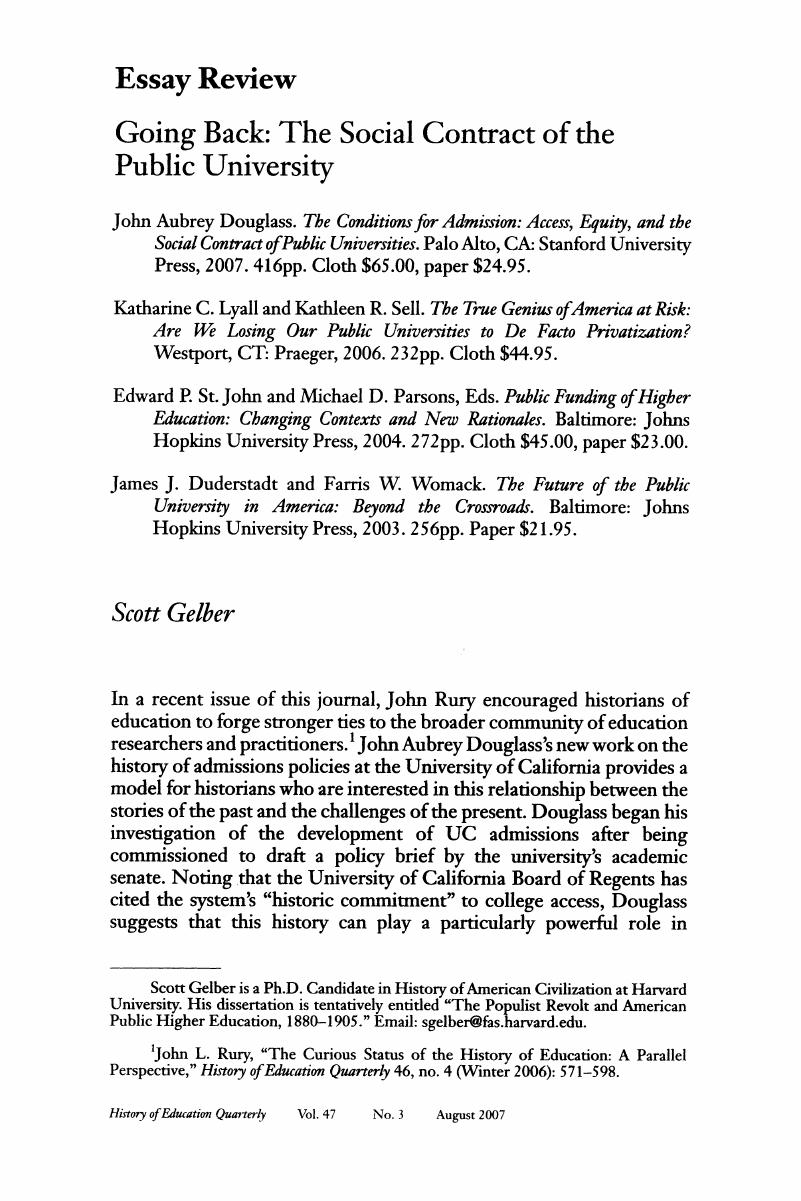Article contents
Going Back: The Social Contract of the Public University
Published online by Cambridge University Press: 24 February 2017
Abstract

- Type
- Essay Review
- Information
- Copyright
- Copyright © 2007 History of Education Society
References
1 Rury, John L., “The Curious Status of the History of Education: A Parallel Perspective,” History of Education Quarterly 46, no. 4 (Winter 2006): 571-598.CrossRefGoogle Scholar
2 For Douglass's earlier history of UC, see Douglass, John Aubrey, The California Idea and American Higher Education, 1850 to the 1960 Master Plan (Stanford, CA: Stanford University Press, 2000).Google Scholar
3 Two strong examples of recent historical scholarship on public universities are Dennis, Michael, Lessons in Progress: State Universities and Progressivism in the New South, 1880-1920 (Urbana: University of Illinois Press, 2001) and Nidiffer, Jana and Bouman, Jeffrey P., “The Chasm Between Rhetoric and Reality: The Fate of the ‘Democratic Ideal’ When a Public University Becomes Elite,” Educational Policy 15 (July 2001): 432-452.Google Scholar
4 Indicating the limits of his focus on California, Douglass notes that state universities in the South are an exception to this rule. Because the state did not establish historically black colleges, California also does not allow Douglass to study the extent to which these institutions have become a substantial part of equity debates in many states. For example, see Conrad, Clifton F. and Weerts, David J., “Federal Involvement in Higher Education Desegregation: An Unfinished Agenda,” in Public Funding of Higher Education. Also see Williams, John B., Race Discrimination in Public Higher Education: Interpreting Federal Civil Rights Enforcement, 1964-1996 (Westport, CT: Praeger, 1997).Google Scholar
5 Using data gathered from yearbook photographs, Douglass calculates that Asian Americans were “overrepresented” at UC Berkeley by 1950 (8.5% of enrollment compared to 3% of the California state population) (p. 74). Douglass also concludes that there is no clear evidence to suggest that UC administrators preferred to reject Asian American applicants rather than white applicants after the university removed Asian Americans from affirmative action considerations in 1984.Google Scholar
6 Unfortunately, it seems that the UC archives reveal little about how this admissions policy was implemented at the level of individual applicants. As a result of the 1960 Master Plan, the percentage of UC students legally admissible under this policy decreased from 10 percent to 2 percent, before rising to 4 percent after 1968 and 6 percent after 1979. As of 2006, however, only 3 percent of Berkeley students were actually admitted under special action (pp. 90, 99, 117, 232).Google Scholar
7 Richard Freeland's study of Massachusetts, for example, suggests that private urban commuter schools were just as important to the expansion of college access. Freeland, Richard M., Academia's Golden Age: Universities in Massachusetts, 1945-1970 (New York: Oxford University Press, 1992).Google Scholar
8 Lemann, Nicholas, The Big Test: The Secret History of the American Meritocracy (New York: Farrar, Straus, and Giroux, 1999).Google Scholar
9 The development of these schools into regional public universities during the mid-twentieth century is an important story that has yet to be adequately synthesized by historians. Christine Ogren's analysis of public normal schools in the late nineteenth and early twentieth centuries provides a foundation for studying the subsequent evolution of these institutions. Ogren, Christine A., The American State Normal School: An Instrument of Great Good (New York: Palgrave Macmillan, 2005). For strong recent case studies of these institutions see Trelease, Allen W., Making North Carolina Literate: The University of North Carolina at Greensboro: From Normal School to Metropolitan University (Durham: Carolina Academic Press, 2004); Edmonds, Anthony O. and Geelhoed, E. Bruce, Ball State University: An Interpretive History (Bloomington: Indiana University Press, 2001).Google Scholar
10 For discussion of whether or not community colleges have diverted students from the pursuit of additional higher education, see Brint, Steven and Karabel, Jerome, The Diverted Dream: Community Colleges and the Promise of Educational Opportunity in America, 1900-1985 (New York: Oxford University Press, 1989); Dougherty, Kevin, The Contradictory College: The Conflicting Origins, Impacts, and Futures of the Community College (Albany: State University of New York Press, 2001); Frye, John H., The Vision of the Public Junior College, 1900-1940: Professional Goals and Popular Aspirations (New York: Greenwood Press, 1992).Google Scholar
11 For recent calls for more class consciousness in college access policies, see Bowen, William G., Kurzweil, Martin A., and Tobin, Eugene M., Equity and Excellence in American Higher Education (Charlottesville: University of Virginia Press, 2005). States such as Virginia, Georgia, North Carolina, and Texas have begun to invest more heavily in financial aid. Ehrenberg, Ronald G., ed., What's Happening to Public Higher Education? (Westport, CT: Praeger Publishers, 2006).Google Scholar
12 Karabel, Jerome, The Chosen: The Hidden History of Admission and Exclusion at Harvard, Yale, and Princeton (New York: Houghton Mifflin, 2005).Google Scholar
13 Hawkins, Hugh, Between Harvard and America: The Educational Leadership of Charles W. Eliot (New York: Oxford University Press, 1972): 167.Google Scholar
- 1
- Cited by




